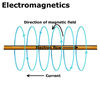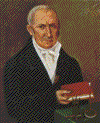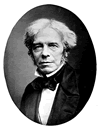 There is an important relationship between magnetism and electricity
that powers much of today's world - the fact that a magnetic field is
produced when there is an electric current in a wire.
There is an important relationship between magnetism and electricity
that powers much of today's world - the fact that a magnetic field is
produced when there is an electric current in a wire.
An electric bell is one common device that uses a magnetic force created by a current in a wire. Others are electromagnets used in junk yards, electrical transformers and electric motors.
 Early
discoveries
Early
discoveries
Electromagnetism was first observed by a Danish scientist, Hans Christian
Oersted in 1820. It was probably the first time a connection was made
between magnetism and electricity since Allessandro Volta, (pictured right)
invented the battery in 1799. It wasn't until 1831 that an Englishman,
Michael Faraday, (pictured below) discovered that passing a magnet through
a coil of wire caused an electric  current
to flow in the wire. The reverse is also true, an electric current in
a coil of wire will induce a magnet field.
current
to flow in the wire. The reverse is also true, an electric current in
a coil of wire will induce a magnet field.
Transformers
 One of Faraday's most famous inventions was Faraday's ring
where he used a current in a coil to create magnetic field in a ring of
steel, which in turn created a second current in another coil of wire
- the principle of all transformers today. Transformers are used to create
currents in wires and are specifically used in the electricity supply
industry to change the voltage and current of electricity supplies.
One of Faraday's most famous inventions was Faraday's ring
where he used a current in a coil to create magnetic field in a ring of
steel, which in turn created a second current in another coil of wire
- the principle of all transformers today. Transformers are used to create
currents in wires and are specifically used in the electricity supply
industry to change the voltage and current of electricity supplies.
Simple electromagnets
An easy way to demonstrate electromagnetism is with an iron nail, a length
of insulated wire, an electric cell and a compass. Wind the wire into
a coil, connect both ends to the electric cell, then insert the iron nail
through the centre of the coil. Bring the compass close to the nail and
observe the deflection. The electric current in the wire has induced an
alignment of magnetic domains in the nail. Now disconnect one end of the
wire from the cell and observe what happens.
Note: Be very careful not to touch the exposed wire ends as they are likely to be hot. This experiment is best done for a few seconds at a time, to stop the wires overheating.

|
Electromagnetism |
The nail loses most of its magnetism when the electric current is turned off because it is made of "soft" iron, meaning that the magnetic domains don't stay permanently lined up. Permanent magnets are made of "hard" iron and, once magnetised the domains remain aligned.
Electric bells
The electric bell uses a soft iron core in a coil of wire connected at
one end to a power supply and a spring that touches the other terminal
with a striker at the end. When there is no current the striker is held
away from the bell by a spring, but when a current passes through the
circuit the iron core forms an electromagnet and pulls the striker which
in turn hits the bell.

|
Electric bell |
Here is the clever bit - as the spring is drawn towards the electromagnet, it loses contact with the electrical terminal and turns off the current. Because the electromagnet has only temporary magnetism, the spring is released and flies back towards the contact. The circuit is now complete and the process continues! What an innovative combination of electromagnetism, kinetic energy and sound energy as the vibrating bell compresses air which your ear interprets as sound.
The principle of electromagnetism is applied to many devices, including audio speakers, solenoids that connect your car's starter motor to the engine, machines holding steel sheets in place while being cut or bent, and even as massive cranes that lift scrap steel when the electric current is on, and drop it again when the current is switched off. You can make a model crane using a simple electromagnet and paper clips. Be sure that the paper clips are steel, not brass or plastic which are not attracted to magnets.
| Copyright owned by the State of Victoria (Department of Education and Early Childhood Development). Used with Permission. |